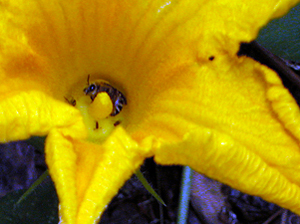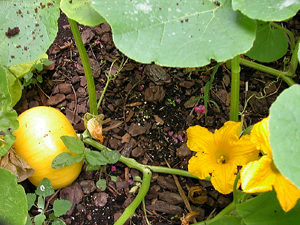 Every flower is an invitation, people. Perfectly respectable plants swallow up a bunch of energy, generate a bud and a bloom, and then bang out an explosion of color and scent and pollen and nectar. There has to be an important reason to go to this much effort, to divert this many resources from the business of photosynthesizing and growing, and wouldn't you just know that it has to be sex?
Every flower is an invitation, people. Perfectly respectable plants swallow up a bunch of energy, generate a bud and a bloom, and then bang out an explosion of color and scent and pollen and nectar. There has to be an important reason to go to this much effort, to divert this many resources from the business of photosynthesizing and growing, and wouldn't you just know that it has to be sex? I'm being bombastic here, but it's caused by just a bit of (non- reproductive) frustration. With the impact that Colony Collapse Disorder (CCD) has had on the news in this country, and the opportunity it has given to truly show people the most important part of the honeybee-human relationship, I'm still having trouble explaining pollination to kids. It's basically the way in which plants get the male bit (pollen on the stamens) over to the female bit (the ovaries in the pistils), hopefully on a different plant. They overproduce the pollen to guarantee coverage and offer a protein food, they produce nectar THEY DON'T EVEN USE down near the bottom to get the dusty bees to go where the action is. This picture shows the act in progress at the right, and the fruit of the deed at the left.
I'm being bombastic here, but it's caused by just a bit of (non- reproductive) frustration. With the impact that Colony Collapse Disorder (CCD) has had on the news in this country, and the opportunity it has given to truly show people the most important part of the honeybee-human relationship, I'm still having trouble explaining pollination to kids. It's basically the way in which plants get the male bit (pollen on the stamens) over to the female bit (the ovaries in the pistils), hopefully on a different plant. They overproduce the pollen to guarantee coverage and offer a protein food, they produce nectar THEY DON'T EVEN USE down near the bottom to get the dusty bees to go where the action is. This picture shows the act in progress at the right, and the fruit of the deed at the left.Flowers truly are miracles: tell me, if the only kind of intelligence is the human kind, how did every plant that sets a seed come to (successfully) open up its reproductive process to third-party participation? I don't mean to say that plants are out there secretly hedging foreign currency markets, but that our ways of gathering and leveraging knowledge are based on the space we live in. The fish in the pond out front are smart in finny ways, my dogs are good at sniffing and stealing, and people excel at thinking about themselves.
But if you do somehow find yourself thinking about flowers, you can easily see the wonderful shopping experience they represent for the bees. Every one is attempting to cut the deal that gets the pollination done. Some, like apple trees, are hard bargainers: each bloom is pip-squeaky about how much nectar and pollen it doles out, but there are tons of flowers, all nearby, and not much else going at the time. The honeybee in my back yard, in the picture up there, is just about drunk as a skunk in a puddle of nectar on the bottom of THAT bloom. The deal is probably like this: "I know you have lots of places to go, and things to do, but I will fill you up in one swell stop, and invite you to root around ALOT by offering tons of nectar and pollen. Unfortunately, I am only open mornings, so I need to get you here right away (so I will make a huge, bright flower)." You know all those seeds inside a pumpkin? Each one required a pollen grain delivery, so you can see that the plant wants that bee in there a long time, rolling around.
So each plant develops its marketing strategy of size, color, smell, rewards, and even configuration to attract the right kind of pollination. Some even concoct little landing strips that you can see in UV light: they kind of point at the good stuff. So next time you walk in a garden, or a flowery field, experience the sales pitch. A whiff of wonderful scent turns your head one way, a glorious bloom makes your head tilt right, a carpet of color draws your eye down. It reminds me of walking in markets in the Middle East, where vendors and merchants call to you, invite you to dicker, and serve you a cup of sweet tea.
But don't try to deal with the corn. The wind-pollinated crops, like grasses, don't even try. They just shake their tassles in a self-satisfied way.
2 comments:
Thanks for your blog! It is serving as an inspiration to me. Next spring....:)
You are such a great writer, T. Seriously. This blew me away.
Post a Comment